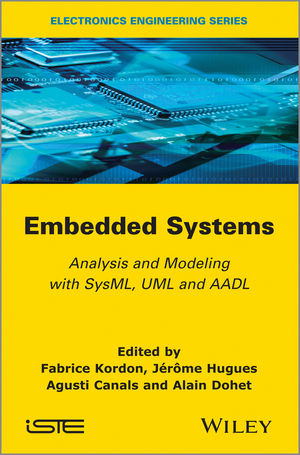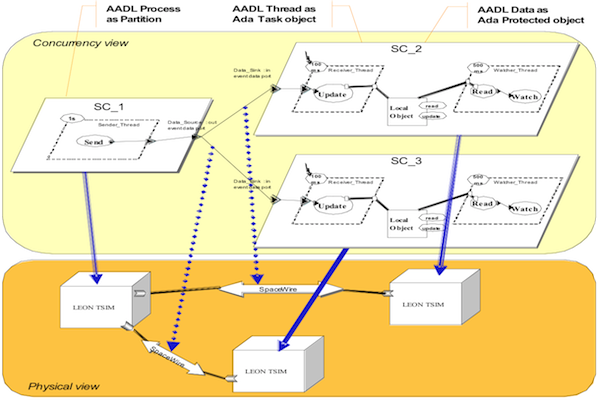Blog
2013
Blog post @ SEI April 29, 2013.
The SEI blog is introducing a series of post on AADL. Ocarina and related activities like ASSERT/TASTE gets featured in the post “AADL Tools: Leveraging the Ecosystem”, see the following link for more details: SEI blog post
AADL tutorial - part 2 April 22, 2013.
A commented example
The following example is a complete AADLv2 model. It exhibits a full hierarchy of component types, and component implementations.
You’ll note we do not provide implementations for subprograms and threads: these are fully determined using properties.
AADL being a textual language, it follows many conventions from other languages: packages, declarations of types and implementations. Let us review the first set of elements:
-- This small example is a basic AADL model, with a full hierarchy of components
package Hello_World
-- Entities are attached to a package
public
subprogram Hello_Spg_1
-- Simple subprogram: actual behavior, not modeled in AADL
properties
Source_Language => (C); -- Implementation language is C
Source_Name => "user_hello_spg_1"; -- Name of the corresponding C function
Source_Text => ("hello.c"); -- Implementation file
end Hello_Spg_1;
thread Task
-- A task: a concurrent flow of execution
properties
Priority => 1; -- Priority, interpretation given by the processor
Dispatch_Protocol => Periodic; -- Periodic
Period => 1000 ms; -- Period of the task
Compute_Execution_Time => 0 ms .. 3 ms; -- Execution time
Compute_Entrypoint => classifier (Hello_Spg_1); -- Hello_Spg_1 is executed at each dispatch
end Task;
process node_a
-- A process, gathers several threads as subcomponents
end node_a;
process implementation node_a.impl
subcomponents
Task1 : thread Task;
end node_a.impl;
processor cpu
-- A processor provides execution resources
properties
Scheduling_Protocol => (RMS); -- How thread are given access to the CPU
end cpu;
system rma
-- A system combines both hardware and software elements
end rma;
system implementation rma.impl
subcomponents
node_a : process node_a.impl;
cpu : processor cpu;
properties
Actual_Processor_Binding -- Binding relations between hardware and software
=> (reference (cpu)) applies to node_a; -- node_a is allocated resources on cpu
end rma.impl;
end Hello_World;
Book on SysML/MARTE/AADL April 20, 2013.
A new book covering SysML, UML/MARTE and AADL is available at Wiley, and Hermes (French Version).
This book presents how a common case study (Pacemaker specifications from the pacemaker challenge) can be modeled and analyzed using SysML, UML/MARTE and AADL. It is a joint effort of the french MDE community to compare the different approaches. For each formalism, we propose an introduction to the notation, and then how to model, analyze and generate code from these specifications. Analysis focuses on model checking of the system.
Hence, interested readers can build their own opinion on the value of each approach.

AADL tutorial - part 1 April 15, 2013.
About AADLv2
The “Architecture Analysis and Design Language” AADL is a textual and graphical language for model-based engineering of embedded real-time systems. It has been published as an SAE Standard AS5506B. AADL is used to design and analyze the software and hardware architectures of embedded real-time systems.
AADL allows for the description of both software and hardware parts of a system. It focuses on the definition of clear block interfaces, and separates the implementations from these interfaces. It can be expressed using both a graphical and a textual syntax. From the description of these blocks, one can build an assembly of blocks that represent the full system. To take into account the multiple ways to connect components, the AADL defines different connection patterns: subcomponent, connection, and binding.
An AADL model can incorporate non-architectural elements: embedded or real-time characteristics of the components (such as execution time, memory footprint), behavioral descriptions. Hence it is possible to use AADL as a back- bone to describe all the aspects of a system. Let us review all these elements:
An AADL description is made of components. The AADL standard defines software components (data, thread, thread group, subprogram, process) and execution plat- form components (memory, bus, processor, device, virtual processor, virtual bus) and hybrid components (system). Each Component category describe well identified elements of the actual architecture, using the same vocabulary of system or software engineering:
-
Subprograms model procedures like in C or Ada.
-
Threads model the active part of an application (such as POSIX threads). AADL threads may have multiple operational modes. Each mode may describe a different behavior and property values for the thread.
-
Processes are memory spaces that contain the threads. Thread groups are used to create a hierarchy among threads.
-
Processors model microprocessors and a minimal operating system (mainly a scheduler).
-
Memories model hard disks, RAMs, buses model all kinds of networks, wires, devices model sensors, …
-
Virtual bus and Virtual processor models “virtual” hardware components. A virtual bus is a communication channel on top of a physical bus (e.g. TCP/IP over Ethernet); a virtual processor denotes a dedicated scheduling domain inside a processor (e.g. an ARINC653 partition running on a processor).
Unlike other components, Systems do not represent anything concrete; they combine building blocks to help structure the description as a set of nested components.
Packages add the notion of namespaces to help structuring the models. Abstracts model partially defined components, to be refined during the modeling process.
Component declarations have to be instantiated into subcomponents of other components in order to model system architecture. At the top-level, a system contains all the component instances. Most components can have subcomponents, so that an AADL description is hierarchical. A complete AADL description must provide a top-most level system that will contain certain kind of components (processor, process, bus, device, abstract and memory), thus providing the root of the architecture tree. The architecture in itself is the instantiation of this system, which is called the root system.
The interface of a component is called component type. It provides features (e.g. communication ports). Components communicate one with another by connecting their features. To a given component type correspond zero or several implementations. Each of them describes the internals of the components: subcomponents, connections between those subcomponents, etc.
An implementation of a thread or a subprogram can specify call sequences to other subprograms, thus describing the execution flows in the architecture. Since there can be different implementations of a given component type, it is possible to select the actual components to put into the architecture, without having to change the other components, thus providing a convenient approach to configure applications.
The AADL defines the notion of properties that can be attached to most elements (components, connections, features, etc.). Properties are typed attributes that specify constraints or characteristics that apply to the elements of the architecture: clock frequency of a processor, execution time of a thread, bandwidth of a bus, . . . Some standard properties are defined, e.g. for timing aspects; but it is possible to define new properties for different analysis (e.g. to define particular security policies).
AADL is a language, with different representations. A textual representation provides a comprehensive view of all details of a system, and graphical if one want to hide some details, and allow for a quick navigation in multiple dimensions. In the following, we illustrate both notations. Let us note that AADL can also be expressed as a UML model following the MARTE profile.
The concepts behind AADL are those typical to the construction of embedded systems, following a component- based approach: blocks with clear interfaces and properties are defined, and compose to form the complete system. Besides, the language is defined by a companion standard document that documents legality rules for component assemblies, its static and execution semantics.
The following figure illustrates a complete space system, used as a demonstrator during the ASSERT project. It illustrates how software and hardware concerns can be separately developed and then combined in a complete model.

New AADL Web site January 6, 2013.
Welcome aboard OpenAADL website !
I (Jerome Hugues) operate this website as part of my commitment to the AADL standard. I’m member of the AADL standardization committee since 2006, and part of the steering board since 2011.
The objective of this website is to provide resources around the SAE AADL architecture description language, and links to tools and projects I’m involved in either directly, or as part of the AADL community.
This site is divided as follows
-
Home is the welcome page;
-
The
Projectsmenu provides access to tools that support AADL features, bring specific analysis capabilities, or some utility packages. -
Download provides direct links to downloadable resources,
-
Blog provides access to blog archives, providing tutorials on AADL and updated on the standard.
All contents on this website is licensed under a Creative Commons Attribution-NonCommercial-NoDerivs 3.0 Unported License.